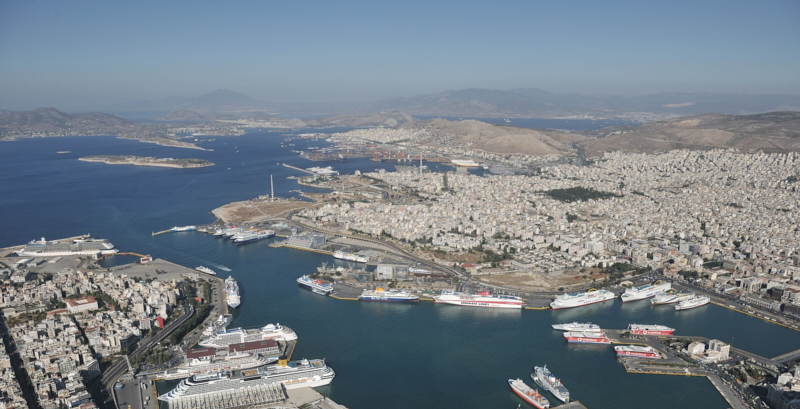Ferry Shipping News visited Port of Piraeus a few weeks ago and met with Mr. Nektarios Demenopoulos, Deputy Manager/Public & Investor Relations of the port. We talked about the ferry and roro traffic, cruise calls, the protection of the environment as well as the present and the future of the biggest Greek Port.
The Port of Piraeus (PPA SA) is the largest port in Greece, spanning a coastline of more than 24km in length and expanding over an aggregate area exceeding five million square meters. The geographic location of the Piraeus Port makes it a vital transportation, trade and supply, tourism and communication hub connecting the Greek islands with the mainland, as well as being an international centre of marine tourism and the commercial passage of cargos. The position of the Piraeus Port is conducive to its operation both as a commercial and touristic gate of Greece and as transhipment hub for the Balkans and Black Sea countries.
Coastal Ferry shipping (figures, passenger and car volumes).
Current trend
+5.7% passengers / 16.5 million passengers
In 2019, total passenger traffic in the domestic lines recorded an increase of 5.7% to 16,551,054 compared to 15,657,368 passengers in 2018. An increase is recorded in all individual routes including the urban ferry connection Perama-Salamina which before recorded a decrease in traffic over the last three years.
In particular, coastal services and urban ferry connection Perama-Salamina, which account for 85% of total traffic, increased by 7.2% and 3.1% respectively.
Growth is also recorded in the sector of vehicle traffic, despite individual vehicle type variations across all inland routes (2,742,213 in 2019 versus 2,646,189 in 2018).
RoRo Car terminal (figures and freight volumes).
Current trend
-5.9% cars
The car terminals saw a decrease by 5.9%, due to the reduction in transhipment cargo. In 2019, total traffic was 403,757 vehicles versus 429,170 in 2018. It is important to note that the domestic market volumes increased by 3.5% (from 116,737 in 2018 to 120,803) while the transhipment cargo decreased by 9.4% (282,954 units to 312,433 units in 2018). The drop in volume is a result of both reduced demand from the main markets in the eastern Mediterranean and in particular Turkey and Egypt and reduced sales in Europe. Despite the overall decrease in traffic, the revenue trend was positive due to the increase in domestic cargo, which confirms the positive outlook for the activity.
Cruise
+14.2% cruise passengers / 1.1 million
PPA SA’s outward focus and dedication to cruise attraction policy coupled with increased demand for cruises in the eastern Mediterranean have contributed to the increase in cruise offerings. Piraeus in 2019 recorded significantly increased volumes of passengers and arrivals compared to 2018. At the passenger level there was an increase in both homeport and transit passengers. In particular, total passenger traffic in 2019 was 1,098,091 compared to 961,632 in 2018, recording a 14.2% increase.
Cruise start or end passengers (homeport) reached 410,512 against 354,398 in 2018, up 15.8%.
Cruise ship arrivals increased by 18.7% to 622 against 524 the year before.
In 2019 the port of Piraeus won the first place -in the Mediterranean- in container traffic (surpassed Valencia) and awarded as the best cruise port in Mediterranean. What is next?
The strategic objectives of the Company are divided into four axes:
- Leadership for a homeport cruise in the Mediterranean: Attract additional 580,000 homeport cruise passengers (as a port of departure) from which 100,000 to come from China in order to create a significant benefit to the local economy. The necessary supporting investments will be made to upgrade the hotel infrastructure, commercial and other activities.
- East Mediterranean Ship repair Node: Installing a new Floating Dock and reviving Naval Repairs by attracting 350-450 ships per year as a result of competitive pricing, increased reliability and efficient service.
- Southern gateway to Sino-European trade: Expanding the Container Terminal’s activities through land-based interconnection with transit centers (trains), attracting new Ro-Ro customers and expanding supply chain activities with the construction of new modern warehouses.
- Passenger Port across Greece: Maintaining the existing level of activity and upgrading the services provided through targeted investments (e.g. parking, dredging, commercial activity).
New investments. What is coming next after the approval of the PPA’s new master plan from the Hellenic Government?
In addition to boosting the Company’s financial position, the implementation of PPA S.A.’s mandatory investment programme is expected to have multiple benefits for the local and national economy, as well as for society as a whole. Since the start of each project implementation and until the 31st of December 2019, investments of €71,027,181 were completed, concerning both mandatory investments projects (totalling €293,783,800, resulting from the mandatory investments of the Concession Agreement’s with the Greek Government) and additional voluntary Company investments of about €300,000,000.
In your future master plan have you taken into consideration any provisions about the protection of the environment and which are these?
PPA SA recognizes that the resources consumption must be granted in an efficient way across the port sector. Piraeus’ port nature and size favors a high amount of daily energy consumption (e.g. ship-to-shore cranes, terminals lighting, reefer containers, administration buildings, workshops). PPA S.A. raises awareness on the subject by promoting initiatives and behaviors to improve the balance of the demand and supply of energy and to reduce energy consumption.
PPA SA has recognized the need to reduce resource consumption and particularly the energy saving while continuing to provide a secure working environment. Electricity and oil usage have been identified in various energy efficiency reviews as an area for potential reduction.
Indicative energy saving measures implemented by PPA SA are:
- Staff environmental awareness
- Purchasing of electrical equipment with > A energy class and certification
- Improvement of buildings’ energy efficiency
Spyridon Roussos


